Scissor beak, aka: crossed beak, crooked beak, is a condition in which the top and bottom beaks do not align properly. It can be caused by genetics, an injury or the inability to maintain the beak’s length and shape by normal honing on rocks or other hard surfaces.
One of my first chicks, Esther, an Easter Egger, was born with with this common genetic deformity. It was so mild that I did not notice it for weeks. Scissor-beak varies in severity, but most chicks can eat and drink independently. Crossed beak need not be an automatic death sentence as believed by some. Most cross-beaked chicks adapt and thrive, leading long, happy lives. However, there are some chicks in which the defect is too severe for them to eat or drink independently and they can not survive without constant assistance.
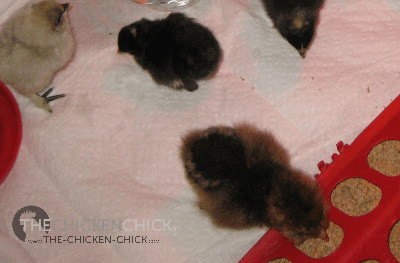
Esther lived four years until without help eating or drinking. She was put to sleep after being diagnosed with cancer throughout her oviduct and other organs and she is dearly missed. It did take her more time and effort to eat than the other chickens and she was never as large as the other birds, but that is to be expected.
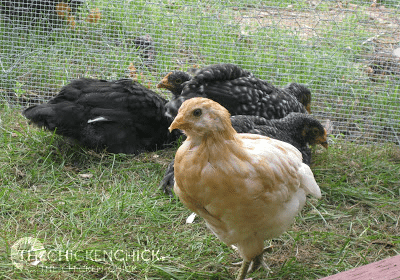
Since crossed beaked chickens cannot pick up pieces of food using both halves of their beaks as utensils, they adapt by scooping food into the bottom half of their beaks. I find that it helps to put Esther’s feed in a deep dish, raised up to chest level so it has less distance to travel to reach her tongue than if it were on the ground. This small adaptation is sometimes all it takes to help crossed-beaked chickens eat.
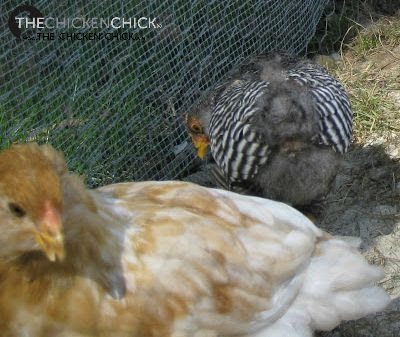
Some chickens find it easier to eat a feed to which water has been added to make it the consistency of oatmeal. Grinding up feed in a coffee grinder and adding water to make a wet mash may help severely scissor-beaked chickens.
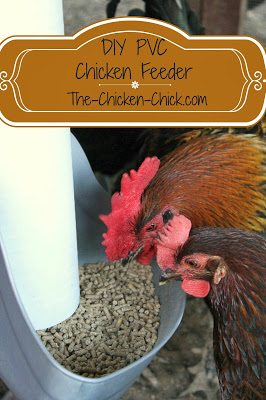
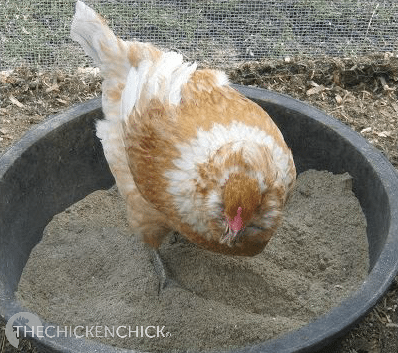
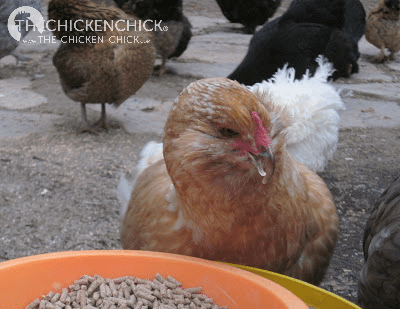
The important thing to watch out for with this condition is that the chicken is able to eat, not only due to their physical limitations but because other flock members may attempt to keep them away from the feed. If that occurs, the chicken should be put in a safe place where only she can access the feed.
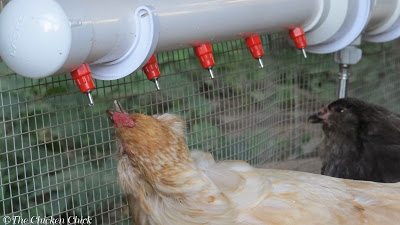
I have found that using a poultry nipple watering system has made drinking much less of an effort for Esther as the water drips into her mouth instead of her having to stoop down, scoop up some in her lower beak and hope that it makes it to the back of her throat when she stands up straight.
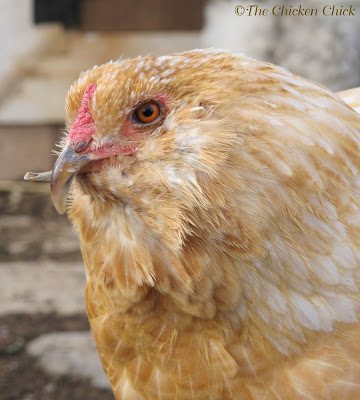
Chickens maintain the length and shape of their beaks by wiping them on rocks or other abrasive surfaces while foraging, but scissor beaked chickens have difficulty with this routine task. Due to the severity of Esther’s defect, she cannot hone her beak length independently and we periodically trim it for her using dog nail clippers. A Dremmel tool or file can accomplish the same objective, but the vibration from those methods may be more upsetting to the bird than a quick slip with nail clippers..
(Note: Chickens confined to a run should be provided with a paver, brick or cement block for beak honing.)
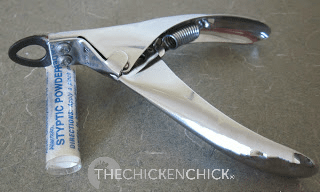
When trimming Esther’s beak, we always have styptic powder at the ready in our chicken first aid kit. Beaks are vascular and if cut too far back, will bleed profusely. Unfortunately, I know this from first-hand experience and it was a frightening lesson in preparedness.
When chicks have scissor beak, it is safe to assume that genetics are to blame, therefore breeding them as adults is not recommended since the condition can be passed down to future generations.
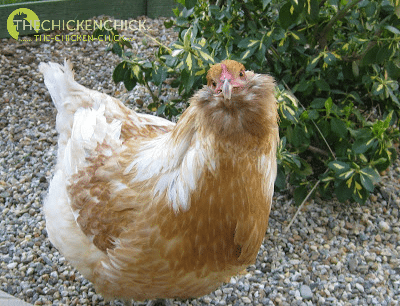
Kathy Shea Mormino
Affectionately known internationally as The Chicken Chick®, Kathy Shea Mormino shares a fun-loving, informative style to raising backyard chickens. …Read on


shop my SPONSORS
Scissor beak, aka: crossed beak, crooked beak, is a condition in which the top and bottom beaks do not align properly. It can be caused by genetics, an injury or the inability to maintain the beak’s length and shape by normal honing on rocks or other hard surfaces.
One of my first chicks, Esther, an Easter Egger, was born with with this common genetic deformity. It was so mild that I did not notice it for weeks. Scissor-beak varies in severity, but most chicks can eat and drink independently. Crossed beak need not be an automatic death sentence as believed by some. Most cross-beaked chicks adapt and thrive, leading long, happy lives. However, there are some chicks in which the defect is too severe for them to eat or drink independently and they can not survive without constant assistance.

Esther lived four years until without help eating or drinking. She was put to sleep after being diagnosed with cancer throughout her oviduct and other organs and she is dearly missed. It did take her more time and effort to eat than the other chickens and she was never as large as the other birds, but that is to be expected.

Since crossed beaked chickens cannot pick up pieces of food using both halves of their beaks as utensils, they adapt by scooping food into the bottom half of their beaks. I find that it helps to put Esther’s feed in a deep dish, raised up to chest level so it has less distance to travel to reach her tongue than if it were on the ground. This small adaptation is sometimes all it takes to help crossed-beaked chickens eat.

Some chickens find it easier to eat a feed to which water has been added to make it the consistency of oatmeal. Grinding up feed in a coffee grinder and adding water to make a wet mash may help severely scissor-beaked chickens.



The important thing to watch out for with this condition is that the chicken is able to eat, not only due to their physical limitations but because other flock members may attempt to keep them away from the feed. If that occurs, the chicken should be put in a safe place where only she can access the feed.

I have found that using a poultry nipple watering system has made drinking much less of an effort for Esther as the water drips into her mouth instead of her having to stoop down, scoop up some in her lower beak and hope that it makes it to the back of her throat when she stands up straight.

Chickens maintain the length and shape of their beaks by wiping them on rocks or other abrasive surfaces while foraging, but scissor beaked chickens have difficulty with this routine task. Due to the severity of Esther’s defect, she cannot hone her beak length independently and we periodically trim it for her using dog nail clippers. A Dremmel tool or file can accomplish the same objective, but the vibration from those methods may be more upsetting to the bird than a quick slip with nail clippers..
(Note: Chickens confined to a run should be provided with a paver, brick or cement block for beak honing.)

When trimming Esther’s beak, we always have styptic powder at the ready in our chicken first aid kit. Beaks are vascular and if cut too far back, will bleed profusely. Unfortunately, I know this from first-hand experience and it was a frightening lesson in preparedness.
When chicks have scissor beak, it is safe to assume that genetics are to blame, therefore breeding them as adults is not recommended since the condition can be passed down to future generations.





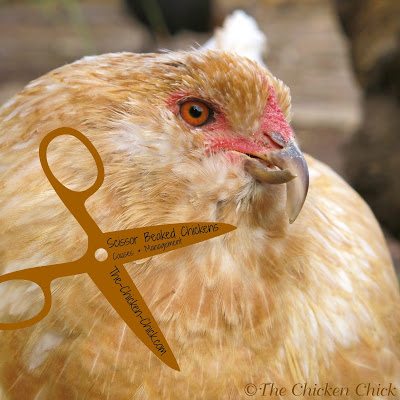
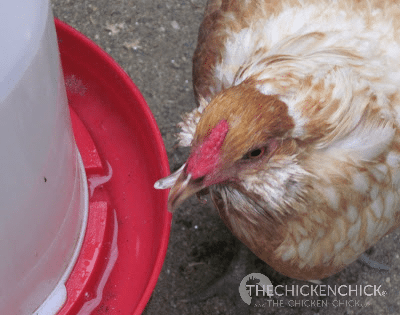

















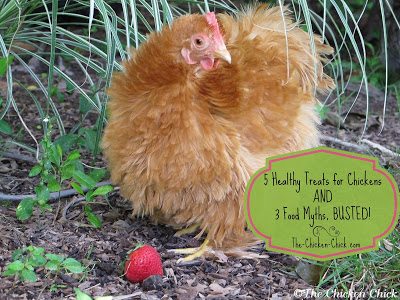

















I am so thrilled to have run across this info! I have had a RIR with the condition, I named her 'Crooked Beak' – I had no idea how or why she was special needs, she also has the funky-smashed-in-like eye!
She has no trouble eating and seems to be quite high in the pecking order of my 28 gals – she hatched in the spring of 2009 and lives very heartily! Thanks for the info and for the shares from everyone else!!
I have a chick that is one week old with this condition. She is also missing an eye. It is pretty severe, and she does not scoop her food or water. I syringe feed her every three hours, and she is doing well. I am just scared that it is going to get worse when she gets older. Is there anything you can do to help prevent it from getting worse? Or do you think it will get better when her beak gets bigger and she will be able to scoop food with it? I couldn't find much information on… Read more »
Never say never but…it seems unlikely that if she is unable to eat and drink on her own that she will do so later on, but it's always possible.
As you can see, Esther's beak got much worse as she grew so she started out self-sufficient and learned to adapt. I worry that your girl may not have the same fighting chance. Just keep an eye on her and see if she can figure it out because without constant daily attention, she won't be able to make it on her own. Bless your heart for helping her get this far.
I love that last pic of Esther! She looks so sassy. Thanks for another great post, Kathy.
She is such a sweet chicken, that photo was totally out of character for her but I had to include it b/c it's just so funny!
Thanks Coco. :)
I have one that has recently been born and it can't walk. He has big legs and feet, but can't seem to hold himself up. I'm not sure what to do. He was born 5 days ago. I've been giving him water with electrolyte for days, but doesn't seem to be able to stand. Gets around fine on the belly. He can't live like that. He is so sweet and cute. Has anyone ever had this problem? Do you think he will catch up and eventually walk on his feet?
Please check out my blog post on spraddle leg, which can be found in the right-hand margin, under 'Find a topic in my Blog' under 'spraddle leg.' Just click on that and it will bring you to the blog post. If the chick appears to have spraddle leg it is very easily fixed but needs to be done as soon as possible for the best result. It is entirely possible for spraddle leg to be fixed within a few days but if not addressed, it can be a permanent deformity that will prevent him from leading a normal life or… Read more »
She looks so sweet! Thankfully in 11 years of keeping chickens, I have never run into this problem, but this is a great post to remember if I ever do. Thanks so much!
Blessings,
Susie
Hi Susie! She is a sweetie. I appreciate your comment and thank you for following along!